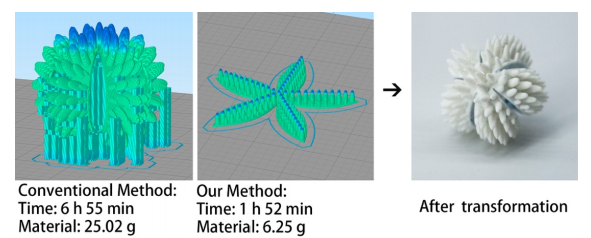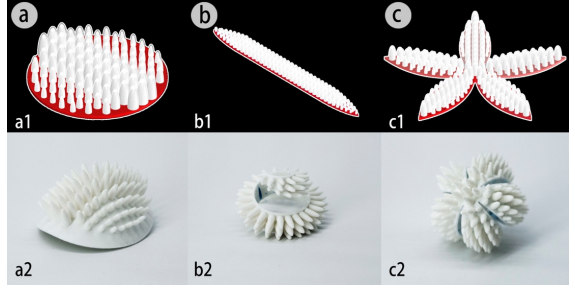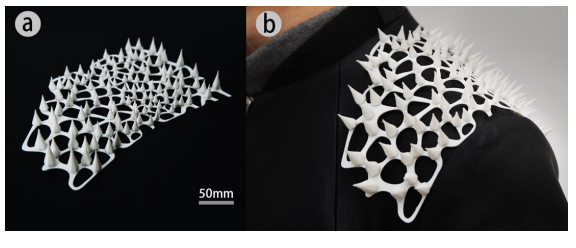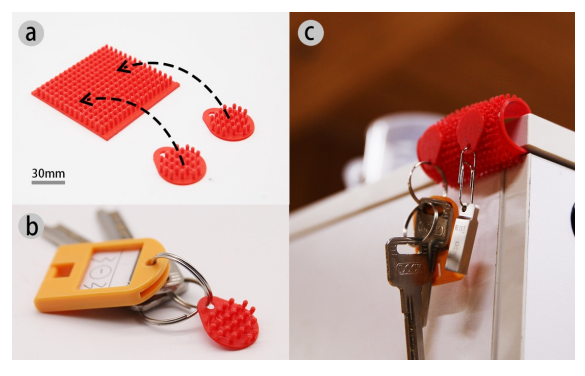

来自美国和中国的研究人员正在将数字制造和材料的质感提升到一个新的水平,他们在最近发表的“ 4D Texture:具有质感的3D表面的形状改变制造方法”中公布了他们的研究结果。
Researchers from both the US and China are taking digital fabrication and texture in materials to the next level, releasing the findings of their study in the recently published ‘4D Texture: A Shape-Changing Fabrication Method for 3D Surfaces with Texture.’
4D打印正在成为许多研究人员感兴趣的领域,但是像3D打印(甚至更多)一样,仍然存在着巨大的未知领域。用户能够超越3D打印的限制,以满足更复杂项目的紧迫需求,例如创建新的元结构,表面以及新的材料和技术。 4D打印为用户提供了更多超越3D的创新,他们也试图制造更复杂的几何形状。
4D printing is growing as an area of interest for many researchers, but like 3D printing—and even more so—there is still enormously uncharted territory. Users are able to move beyond the constraints of 3D printing to meet pressing needs for more complex projects like creating new metastructures, surfaces, and new materials and techniques. 4D printing offers more to users innovating beyond the 3D, seeking to fabricate more complex geometries too.
在这项研究中,作者介绍了一种称为4DTexture的新设计方法,他们将其描述为“整体计算设计和制造方法,利用最先进的4D打印过程使3D表面具有纹理。”
In this study, the authors introduce a new design approach called 4DTexture which they describe as a ‘holistic computational design and fabrication method, leveraging the state-of-the-art 4D printing process to make 3D surfaces with texture.’

传统打印和4DTexture方法之间的时间和材料消耗比较。
Time and material consumption comparison between conventional printing and 4DTexture method.

变形原理:可以在没有支撑结构的情况下打印纹理结构,该结构可以在触发热后转变为3D纹理形状。
Shape-changing principle: the textured structure can be printed without a support structure, which can transform into a 3D textured shape after heat triggering.
虽然3D打印的好处对于工业用户来说是巨大的,而且将继续是巨大的,但是4D打印却为制造领域开辟了新的领域,而这些领域通常也无法通过传统技术来探索。在这项研究中创建的新技术允许使用垂直纹理结构制造执行器-后来将其转换为更复杂的形式。该系统在带有草Grass的Rhino上运行,包括以下用于预览和自定义的内容:
While the benefits of 3D printing are and continue to be vast for industrial users, 4D printing opens up new areas for fabrication that usually cannot be explored through conventional technology either. The new technique created in this study allows for actuators to be made with vertical texture structures—later to be turned into more complicated forms. The system runs on Rhino with Grasshopper, comprised of the following for preview and customization:

工作流程:用户可以(a)设计纹理元素,(b)执行器的形状,定义变换类型,(c)纹理的排列类型,(d)设置纹理趋势,然后(e )生成可以由FDM打印机打印的g代码文件,最终用户可以获得(f)可以热触发为(g)目标3D形状的已打印平板。
The workflow: users can (a) design the element of texture and (b) the shape of actuator, define the transformation type and (c) the arrange type of the texture, (d) set the tendency of the texture, then (e) generate the g-code file which can be printed by an FDM printer, finally users can obtain (f) the printed flat piece which can be heat triggered into (g) the target 3D shape.
随着研究人员建立起一个由半球,金字塔和半圆柱体等形状组成的“库”,对纹理结构进行了实验。该程序提供了一些工具,以便可以自定义参数。例如,设计人员可以使用先前项目提供的4D变形机制,也可以根据需要修改设置。一旦设定了执行器形状,就可以排列纹理。可以选择高度和大小,用户也可以移动纹理。
Experiments were performed on textured structures as the researchers built up a ‘library’ consisting of shapes like hemispheres, pyramids, and hemicylinders. The program offers tools so that parameters can be customized; for example, designers can use offered 4D morphing mechanisms from previous projects or modify the settings if needed. Once the actuator shapes are set, textures can be arranged. Height and size can be chosen, and users can also move textures.
PLA与MakerBot Replicator 2X一起使用,因为研究人员使用硬件的默认值打印了样本纹理,从而产生了自升,自卷和自弯曲的对象。
PLA was used with a MakerBot Replicator 2X as the researchers printed sample textures using the defaults for the hardware, producing self-rising, self-coiling, and self-bending objects.

转换类型:(a)自升(b)自卷和(c)自弯曲。
Transformation types: (a) self-rise (b) self-coil and (c) self-bend.
研究人员说:“可以通过打印方向控制转换机制,该方向已经嵌入到我们的系统中以模拟行为。”
“The transformation mechanism can be controlled by the printing direction, which has been embedded into our system to simulate the behavior,” stated the researchers.
就像3D打印允许各种不同的方式进入时尚一样,4D打印也是如此,它带来了可以根据需要变形和移动的材料的所有优点。在这项研究中,研究人员制造了时尚配饰,模块化玩具,触觉手柄和3D紧固件。
Just as 3D printing has allowed for a variety of different forays into fashion, 4D printing has too, bringing all the benefits of materials that can morph and shift as needed. In this study, the researchers fabricated fashion accessories, a modular toy, a haptic handle, and 3D fasteners.

服装设计:(a)平面印刷件; (b)装饰性场景。
Fashion design: (a) The flat printed piece; (b) The decorative scenario.

定制的触觉手柄:(a)平面印刷件; (b)使用场景。
Customized haptic handle: (a) The flat printed piece; (b) The usage scenario.

3D紧固件:(a)平面印刷件; (b,c)使用场景。
3D fasteners: (a) The flat printed piece; (b, c) The usage scenario.
研究人员总结说:“我们希望这样的系统可以通过爱好者FDM打印机扩展4D打印技术的设计机会。” “将来,我们计划实施系统的材料实验,以提高变换精度,并使用Grasshopper调整参数设置,以使设计工具更加人性化。我们还发现纹理结构可以用作受约束的层,需要进一步研究。”
“We hope such a system can expand the design opportunity of 4D printing technology with a hobbyist FDM printer,” concluded the researchers. “In the future, we plan to implement a systematic material experiment for improving transformation accuracy and fine-tune the parametric setting with Grasshopper to make the design tool more user-friendly. We also found that the texture structure can serve as a constrained layer which needs further investigation.”